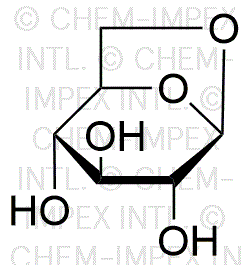1,6-Anhydro-b-D-glucopyranose is widely utilized in research focused on:
- Food Industry: This compound serves as a natural sweetener and bulking agent in various food products, enhancing flavor while reducing caloric content.
- Pharmaceuticals: It is used in the formulation of drug delivery systems, improving the solubility and bioavailability of certain medications.
- Cosmetics: The compound is incorporated into skincare products for its moisturizing properties, helping to maintain skin hydration and elasticity.
- Biotechnology: It plays a role in the development of biopolymers and biodegradable materials, contributing to sustainable practices in manufacturing.
- Research Applications: This compound is a valuable tool in carbohydrate chemistry studies, aiding in the synthesis of complex carbohydrates and glycosides.
General Information
Properties
Safety and Regulations
Applications
1,6-Anhydro-b-D-glucopyranose is widely utilized in research focused on:
- Food Industry: This compound serves as a natural sweetener and bulking agent in various food products, enhancing flavor while reducing caloric content.
- Pharmaceuticals: It is used in the formulation of drug delivery systems, improving the solubility and bioavailability of certain medications.
- Cosmetics: The compound is incorporated into skincare products for its moisturizing properties, helping to maintain skin hydration and elasticity.
- Biotechnology: It plays a role in the development of biopolymers and biodegradable materials, contributing to sustainable practices in manufacturing.
- Research Applications: This compound is a valuable tool in carbohydrate chemistry studies, aiding in the synthesis of complex carbohydrates and glycosides.
Documents
Safety Data Sheets (SDS)
The SDS provides comprehensive safety information on handling, storage, and disposal of the product.
Product Specification (PS)
The PS provides a comprehensive breakdown of the product’s properties, including chemical composition, physical state, purity, and storage requirements. It also details acceptable quality ranges and the product's intended applications.
Certificates of Analysis (COA)
Search for Certificates of Analysis (COA) by entering the products Lot Number. Lot and Batch Numbers can be found on a product’s label following the words ‘Lot’ or ‘Batch’.
*Catalog Number
*Lot Number
Certificates Of Origin (COO)
This COO confirms the country where the product was manufactured, and also details the materials and components used in it and whether it is derived from natural, synthetic, or other specific sources. This certificate may be required for customs, trade, and regulatory compliance.
*Catalog Number
*Lot Number
Safety Data Sheets (SDS)
The SDS provides comprehensive safety information on handling, storage, and disposal of the product.
DownloadProduct Specification (PS)
The PS provides a comprehensive breakdown of the product’s properties, including chemical composition, physical state, purity, and storage requirements. It also details acceptable quality ranges and the product's intended applications.
DownloadCertificates of Analysis (COA)
Search for Certificates of Analysis (COA) by entering the products Lot Number. Lot and Batch Numbers can be found on a product’s label following the words ‘Lot’ or ‘Batch’.
*Catalog Number
*Lot Number
Certificates Of Origin (COO)
This COO confirms the country where the product was manufactured, and also details the materials and components used in it and whether it is derived from natural, synthetic, or other specific sources. This certificate may be required for customs, trade, and regulatory compliance.


